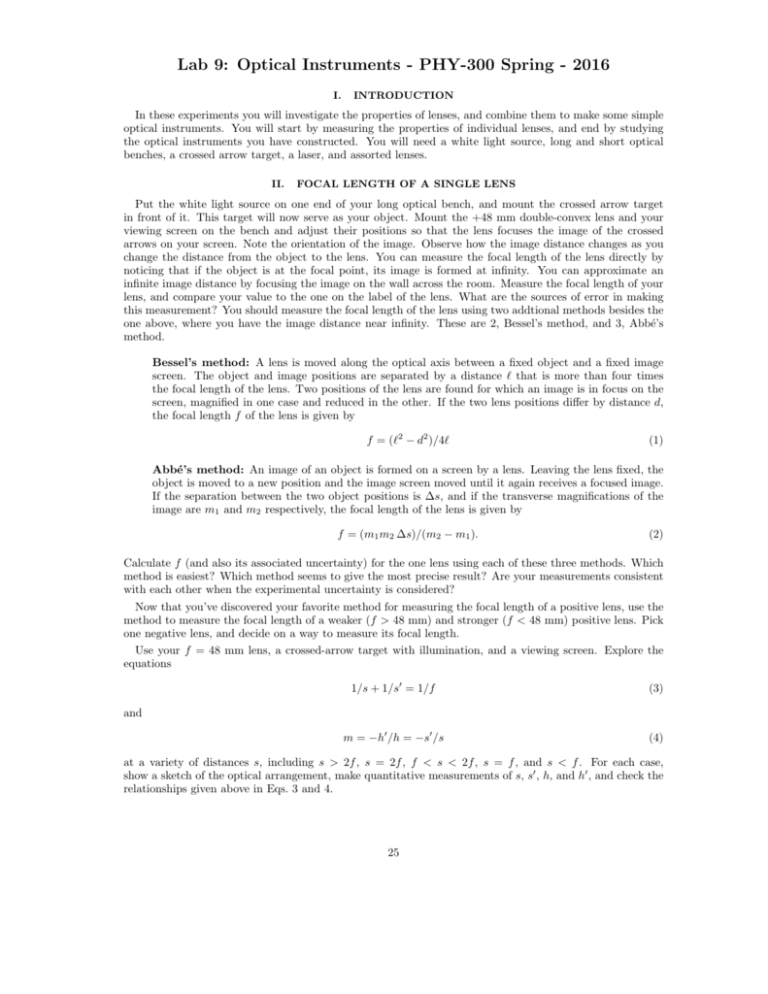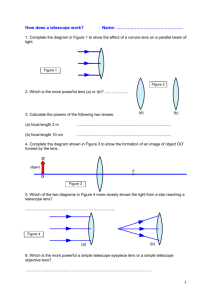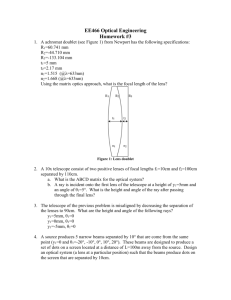Lab 9: Optical Instruments - PHY-300 Spring - 2016
advertisement

Lab 9: Optical Instruments - PHY-300 Spring - 2016 I. INTRODUCTION In these experiments you will investigate the properties of lenses, and combine them to make some simple optical instruments. You will start by measuring the properties of individual lenses, and end by studying the optical instruments you have constructed. You will need a white light source, long and short optical benches, a crossed arrow target, a laser, and assorted lenses. II. FOCAL LENGTH OF A SINGLE LENS Put the white light source on one end of your long optical bench, and mount the crossed arrow target in front of it. This target will now serve as your object. Mount the +48 mm double-convex lens and your viewing screen on the bench and adjust their positions so that the lens focuses the image of the crossed arrows on your screen. Note the orientation of the image. Observe how the image distance changes as you change the distance from the object to the lens. You can measure the focal length of the lens directly by noticing that if the object is at the focal point, its image is formed at infinity. You can approximate an infinite image distance by focusing the image on the wall across the room. Measure the focal length of your lens, and compare your value to the one on the label of the lens. What are the sources of error in making this measurement? You should measure the focal length of the lens using two addtional methods besides the one above, where you have the image distance near infinity. These are 2, Bessel’s method, and 3, Abbé’s method. Bessel’s method: A lens is moved along the optical axis between a fixed object and a fixed image screen. The object and image positions are separated by a distance ` that is more than four times the focal length of the lens. Two positions of the lens are found for which an image is in focus on the screen, magnified in one case and reduced in the other. If the two lens positions di↵er by distance d, the focal length f of the lens is given by f = (`2 d2 )/4` (1) Abbé’s method: An image of an object is formed on a screen by a lens. Leaving the lens fixed, the object is moved to a new position and the image screen moved until it again receives a focused image. If the separation between the two object positions is s, and if the transverse magnifications of the image are m1 and m2 respectively, the focal length of the lens is given by f = (m1 m2 s)/(m2 m1 ). (2) Calculate f (and also its associated uncertainty) for the one lens using each of these three methods. Which method is easiest? Which method seems to give the most precise result? Are your measurements consistent with each other when the experimental uncertainty is considered? Now that you’ve discovered your favorite method for measuring the focal length of a positive lens, use the method to measure the focal length of a weaker (f > 48 mm) and stronger (f < 48 mm) positive lens. Pick one negative lens, and decide on a way to measure its focal length. Use your f = 48 mm lens, a crossed-arrow target with illumination, and a viewing screen. Explore the equations 1/s + 1/s0 = 1/f (3) h0 /h = (4) and m= s0 /s at a variety of distances s, including s > 2f , s = 2f , f < s < 2f , s = f , and s < f . For each case, show a sketch of the optical arrangement, make quantitative measurements of s, s0 , h, and h0 , and check the relationships given above in Eqs. 3 and 4. 25 III. IMAGING WITH TWO-LENS SYSTEMS Telescope: A simple refracting telescope may be constructed using the small optical bench and the lenses in your kit. The objective lens must be a converging lens of relatively long focal length. The eyepiece may be either a converging lens (making a Keplerian or astronomical telescope) or a diverging lens (making a Galilean telescope), but it must be of short focal length. The two lenses should be separated by the algebraic sum of their focal lengths. The magnification of the telescope is defined as the ratio of the angle subtended by the image of a distant object, say, across the room, seen through the telescope to the angle subtended by the same object viewed without the telescope. You can do this using both eyes open, one looking through the telescope and the other looking directly at the object. Compare the sizes. Calculate the ray matrix for each telescope by writing the matrix for each lens and for the space between them, and multiplying (in the right order!), and show that mtelescope = fo /fe where fo and fe are the focal lengths of the objective and eyepiece, respectively (see section 10.4 of Fowles). Construct one of each type of telescope, and estimate the magnification by comparing the size of what you see with one eye through the telescope to the size of what you see through the other (unaided) eye. You must think and play around in order to find a good way of doing this. Compare your measured magnifications with theory, and draw a ray diagram for each telescope. What are the advantages of each type? You can use the two types of telescopes as beam expanders for the laser beam by shining it through the telescope (which way?). Try to measure the diameter of the beam spot of the laser. Then direct the laser through the telescope and compare this “raw” beam diameter and the diameter of the beam after it leaves the telescopes for several distances. What are the relative advantages of using a Galilean over a Keplerian telescope as a beam expander? Microscope: In the microscope, both the objective lens and the eyepiece are converging lenses, but now the objective is the short focal length lens. They should be separated by the sum of their focal lengths plus an additional distance, L. L is called the “tube length” of the microscope. In most microscopes, L = 16 cm. The object to be viewed is positioned so that the image formed by the objective is located at fo + L, which is also the front focal point of the eyepiece. The magnification is defined as the ratio of the angle subtended by the image through the microscope to the angle subtended by the object viewed without the microscope at a distance of 25 cm from the eye. mmicrosope = (25 cm/fe ) ⇥ (L/fo ). Construct at least one microscope and estimate its magnification from your observations. As with the telescope, use both eyes to compare the image sizes. Again, calculate the ray matrix for this optical instrument, and compare it with your experimental estimate. Also, compare the matrix for the microscope with the matrix for your telescope. Comment on their similarities and di↵erences. IV. SINGLE LENS ABERRATIONS This part of the experiment is quite difficult, and is suggested here only if you want to do some advanced work. It is not required. The di↵raction angle of an aperture of diameter d is approximately ✓ = /d, so you want to use a small (d < 10 µm) aperture to spread the laser beam out to several degrees. Use a lens to image the laser light onto the pinhole, and verify that you get a broad, expanding beam out of the pinhole. Measure the approximate angular width of the beam (a more accurate expression is ✓ = 1.22 /d), and compare your result with this formula. Make a divergent point source of light as described above. Use a diaphragm to limit the aperture of a short focal length positive lens, and look at a highly magnified image of the point source. Make sketches (with dimensions indicated!) to indicate your observations of spherical aberrations as a function of diaphragm size, and then (with the diaphragm wide open) make sketches of coma as a function of tilt angle of the lens. Slide the screen a bit either way from optimum focus to observe the stigmatic foci (lines). 26







